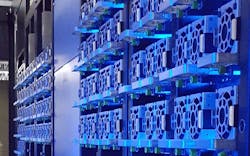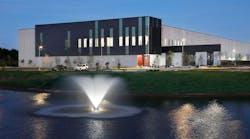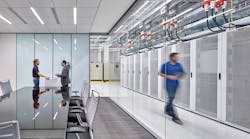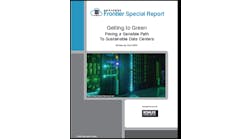In this week’s Voices of the Industry, Scott Sandal, Director of DCIM Support and Services at Sunbird Software, shares seven often-overlooked considerations for a successful data center move.
Whether you’re building a new data center, moving to a colocation facility, or transitioning to a cloud/hybrid environment, a data center move is a complicated, risky endeavor. Many data center migration teams try to mitigate some of the risks and avoid unwelcome surprises through detailed planning and by following best practices.
Scott Sandal, Director of DCIM Support and Services at Sunbird Software
However, even with these efforts, a data center move can be so complex that some things still fall through the cracks. Based on what we’ve seen and heard from our customers, these considerations often aren’t considered at all in the planning and execution of data center migration—despite being critical to its ultimate success.
1. Appoint a migration manager.
With so many moving parts, it’s easy for data center migrations to get derailed, tasks to be forgotten, and key stakeholders to be left out of the loop. Yet many organizations fail to establish an undisputed leader for the migration and instead expect server, application, network, IT, facilities, and other teams to harmoniously divide roles and responsibilities among themselves.
Your migration manager will need to identify and engage all organizational functions/stakeholders that may be impacted by the migration, hold teams accountable for their deliverables, and be the key point of contact for the migration team. Select a migration manager who works well cross-functionally, is familiar with the intricacies of the move, and has the communication skills to provide clear and timely updates to all stakeholders. Most importantly, your migration manager should be empowered to drive the data center migration forward to success.
2. Don’t overplan.
Contrary to popular belief, it is possible to overplan a data center migration. How? By focusing on details that don’t improve your planning or execution.
For example, knowing that Device A is connected to Device B might sound like a relevant detail, but in the actual move, having this information is useful only if you are planning to connect Device A to that exact same Device B. In many cases, you just need to know where the devices should be placed and the new network connectivity.
[clickToTweet tweet=”Scott Sandal – It is possible to overplan a data center migration.” quote=”Scott Sandal – It is possible to overplan a data center migration.”]
Rather than waste time hunting down details that won’t help you during the migration, plan smarter instead. Determine what information you need to complete the data center migration successfully and make sure that this information is provided to the appropriate stakeholders.
3. Create a virtual buildout of your new data center deployment before the physical move.
Many migration teams still do their planning and asset inventory manually in spreadsheets or in drawing tools like AutoCAD or Visio. However, since these files easily become outdated and suffer from poor version control, gaining alignment on a unified vision of your new data center can be a cumbersome challenge. Visualization capabilities and your ability to show network infrastructure are also limited with these tools.
Getting key stakeholders to agree on the end result is much easier when they can see and understand it. Building out a virtual model of the deployment before doing the physical work also can uncover potential issues that can be addressed before the migration. Additionally, articulating the infrastructure design—including the cabinets, power, and network layout—graphically helps ensure that the various teams involved can design and integrate their parts of the deployment seamlessly.
Note: Use discovery and DCIM software for faster, more accurate plans and virtual buildouts. Discovery software can speed the inventory practice by finding most, if not all, devices that are discoverable on your networks. Some Data Center Infrastructure Management (DCIM) software has this functionality as well; however, where DCIM shines is in building your virtual model. DCIM enables you to track assets and changes through a single interface. Moreover, building out your new infrastructure in your DCIM software ensures accuracy in monitoring and operating your data center from Day One.
[clickToTweet tweet=”Create a virtual buildout of your new data center deployment before the physical move.” quote=”Create a virtual buildout of your new data center deployment before the physical move.”]
4. Ensure your cabinets have enough power capacity for your devices.
Whether you can design your cabinets to fit your hardware or you are constrained by the limitations of the cabinets themselves, most data center migrations place devices based only on the amount of space needed in a rack or cabinet. This is understandable given that space is typically the biggest constraint in a data center.
However, having your equipment installed in the appropriate space won’t matter if you don’t have enough power to run your hardware in case of a failover event. To avoid this issue, check that your IT deployment aligns with the power capacity designed for each rack and row to reach failover designs (both on the initial move date and for future provisioning). Have a thorough understanding of the devices that will be housed in your cabinets and design your cabinets for both space and cabinet capacity before the migration. This will help to ensure that you won’t have to spend time or money after the move redesigning your racks or buying new equipment.
5. Implement a labeling system that can be easily understood by everyone involved.
In a data center migration, much of the focus is on how to carefully pack and ship your hardware. However, labeling each piece of equipment to indicate not only whether it should be moved but also who owns it is just as important.
Alphanumeric tags and colored labels are among the most commonly used indicators, but paper printouts can be used to uniquely identify each piece of equipment as well. One of our customers successfully combined 1) a color-coded system to designate which equipment would be moved and 2) paper printouts physically attached to the equipment with instructions for where the equipment would go, what it would be connected to, and the cabling necessary for the connections. (See Point 7 below for other information that should be included on paper printouts.)
Regardless of what indicators you use, the system itself should be simple enough to minimize the risk of confusion and inaccurate migration while still conveying the required information.
6. Install rack components and monitoring sensors prior to the move.
Migrations often take place over weekends, holidays, or off-peak hours, which makes for a limited window of time to complete your hardware move. Late nights and pushing human limits are common variables that will bring a lack of planning to light in a hurry.
Install rail kits and any other hardware that can be installed before your data center migration. This will not only save you time during the physical move but also provide you with an opportunity to familiarize yourself with the site and check that everything is as it should be.
Install blanking panels in the fronts of cabinets where devices will not be installed. This will help the migration team to avoid installing devices in incorrect rails during their late-night efforts. Tape a cabinet elevation model to the inside of the cabinet so the team can easily see how the completed cabinet should look after all hardware has been installed.
Ensure that the configuration of rack power distribution and sensors is completed prior to the move so that a cabinet can be tracked from first install through ongoing utilization and capacity. Furthermore, install the power cables into rack PDU outlets or place them in the floor of the cabinet for easy access during the move.
Note: If your data center migration may take longer than anticipated even with pre-migration hardware installation, consider switching to a phased approach. This also will limit the negative impact to critical resources and applications.
7. Provide a work order for every IT asset.
The team involved in the data center inventory won’t necessarily be the team doing the physical moving and installation. Factor in that your data center migration will probably take place in the middle of the night, and that the team will be working quickly to get it done, and it’s easy to see why a straightforward, easy-to-understand work order or move plan is critical for fast, accurate execution.
Provide an easily accessible work order for each IT asset via hard (paper) copy, tablet, smartphone or another smart device, and/or laptop. Each work order should be simple to read and explain at a glance exactly which cabinet, U position, network cables, power cables, rack PDU outlets, and panel or port switches will be used for every device.
Note: With each IT asset, make sure to include the right lengths of cabling required for its connections. This can make the difference between beautiful, tidy cable management and a “spaghetti” cabinet.
8. Bringing It All Together
Considerations like these may seem obvious after they are articulated, but even the most experienced data center migration teams can (and have) overlooked them. No data center migration is perfect, but you can take action and plan carefully to give yourself the best chance for success.
Keeping these considerations in mind as you plan your data center migration makes for a faster and easier transition and reduces the risk of unanticipated events. They also will help to minimize the time you spend post-migration on addressing mistakes and errors. As a result, you’ll be able to focus on and more quickly reap the benefits of your new data center deployment.
About the Author
Scott Sandal, Director of DCIM Support and Services at Sunbird Software, has over 15 years of experience helping customers with facility capacity planning, IT lifecycle management, and infrastructure design in the data center space.
About Sunbird Software
Sunbird Software is changing the way data centers are managed through radically simplified DCIM software. Sunbird’s Data Center Migration Checklist can help you plan a successful transition—before, during, and after the migration.





